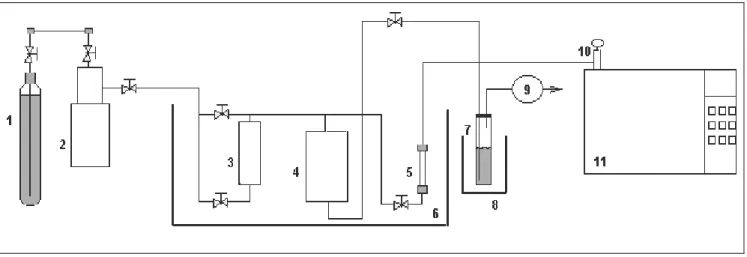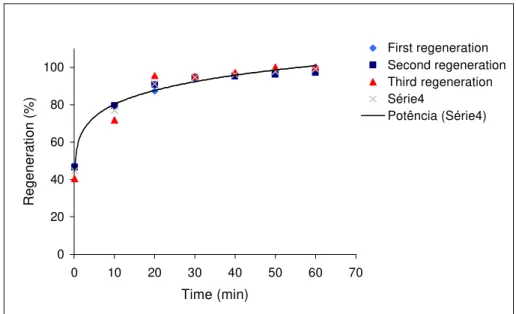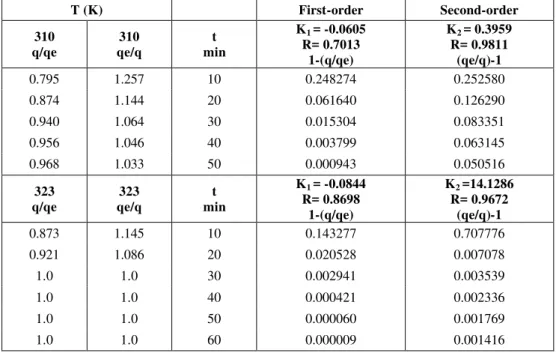ISSN 0104-6632 Printed in Brazil
Vol. 21, No. 04, pp. 641 - 646, October - December 2004
Brazilian Journal
of Chemical
Engineering
DESORPTION OF TOLUENE FROM
MODIFIED CLAYS USING SUPERCRITICAL
CARBON DIOXIDE
D. G. P. Carneiro, M. F. Mendes and G. L. V. Coelho
*Laboratório de Processos de Separação, DEQ/UFRRJ, Antiga Rio-São Paulo, Km 47, 23890-000, Fax: +(55) (21) 2682-1865, Seropédica - RJ, Brazil.
E-mail: mf_mendes@hotmail.com E-mail: coelho@ufrrj.br
(Received: November 25, 2003 ; Accepted: May 10, 2004)
Abstract - The main objective of this work is to study the regeneration capacity of modified clays using supercritical fluid. These modified clays are used as organic compound adsorvents. The experimental step was done using a packed column with the clay contaminated by toluene. The results obtained showed the influence of the density of the supercritical CO2 and of the organic modifier in the desorption process. These
data were modeled with first- and second-order models. Better results were obtained using the second-order model. This study makes possible the scale-up of the desorption process for regeneration of solid matrices using supercritical fluids.
Keywords: Supercritical fluid, desorption process, organic compound adsorvents.
INTRODUCTION
Environmental control is an area of great interest for application of supercritical fluid extraction technology which is constantly improving, by soils contaminated. Industrial solid, liquid and gas residues are currently the biggest environmental worry (Macnaughton and Foster, 1995). Research carried out over the last few years has shown that the supercritical extraction of organic compounds from soils (Dooley et al., 1987) or solid matrix may become an interesting alternative to classical treatments such as solvent extraction or incineration (Barna et al., 1996). The most frequently employed supercritical solvent is carbon dioxide because of its special characteristics and physicochemical properties, e.g., nonflammability, nontoxicity, relatively low cost, higher mass-transfer rate and adjustable extraction ability of organic compounds depending on density. It has proved to be an
effective solvent for regeneration of activated carbon loaded with organic compounds (Modell et al., 1979). In order to understand the adsorption and desorption process, extensive research on new adsorbents for the removal of pollutants has also been carried out. The study of regeneration of these adsorbents is also very important. The regeneration of activated carbon by SC-CO2 after adsorption of
toluene has already been studied experimentally (Tan and Liou, 1990). Normally, the activated carbon is used to reduce and/or to recover organic compounds in effluent streams (Srinivasan et al., 1990; Kikic et al., 1996). The use of clay minerals as adsorbents is of particular interest because of their large specific surface areas. An alternative adsorbent is the modified clay proposed by Coelho et al. (2001). In this work, the regeneration of organoclays loaded with toluene using SC-CO2 at different pressures
(TMA+) as organic modifier, which gave a better organophilic nature to the clay. This kind of study is very important for making it possible to scale-up the regeneration process for application to solid matrices or contaminated soils (Alonso et al., 2002).
EXPERIMENTAL METHOD
The experimental apparatus used for the regeneration measurements at elevated pressures is illustrated in Figure 1.
Preparation of the organoclay: the clay used (montmorillonite) and the TMA+ chloride were purchased from Sigma-Aldrich Canada Ltd. The
TMA+ was used without further purification for modification of the clay.
Regeneration: the toluene was extracted by passing the pure supercritical carbon dioxide through a stainless steel tube charged with clay previous contaminated with 134 µl of organic contaminant. The desorption column (2.7 cm3) was packed with about 1.26 g of the modified clay and glass beads were packed above and below the clay packing, both at a height of about 1.5 cm in order create uniform flow rates. Stainless steel frits were used to hold the organoclay in the column.
Gas chromatographic analyses: a HP 5890 gas chromatograph with a flame ionization detector (silica column type SE-54, 25m, col. 70 oC, inj. 250
o
C and det. 250 oC) was used for this task.
Figure 1: Schematic diagram of the apparatus used for desorption experiments were: 1) gas cylinder (minimum purity of 99.9%, AGA); 2) high pressure pump; 3) saturator; 4) mixing tank (Berghof Labortechnik,
Germany); 5) desorption column; 6) heating bath (FALC FA90, ± 0.1ºC); 7) trap, 8) ice bath; 9) gas meter; 10) six-way valve and 11) gas chromatography.
MODELING OF THE DESORPTION PROCESS
The modeling of the desorption process was based on the model proposed by Chiou and Li (2002). The desorption quantities, time and the equilibrium constant of the process are the variables of the models containing first-order and second-order equations.
The first-order expression is expressed as
1
e e
K
log(q q) log(q ) t
2,303
− = − ⋅ (1)
where qe is the desorbed amount in the equilibrium,
q is the desorbed amount at any time, t is the operational time of the process and K1 is the
constant of the first-order equation that must be estimated.
Rewriting the equation above as a function of the desorption amount and time
1 K
t 2,303
e q
1 10
q
− ⋅
− =
(2)
applicability of this kinetic model to represent the experimental data. The correlation coefficients were so low that they do not give representative values.
The second-order model has the same principle as the first-order model, although it was expressed as a function of qe
2 e 2 e
t 1 t
q =K q +q (3)
Dividing the equation and rewriting it,
e e 2
q
q K t 1 1
q
− =
(4)
Since qe is equal to 100% because of the
experimental step and the q/qe values with time are
known, then
e
2
q 1
1
q t K
− =
⋅
(5)
The straight lines were plotted in terms of (q/qe –
1) as a function of time and show good agreement in comparison with the experimental data using the second-order kinetic model for the regeneration process.
RESULTS AND DISCUSSION
The results obtained in the clay regeneration process are shown in Figures 2, 3 and 4. The data show that more than one regeneration in the same matrix of adsorbent did not really change the kinetics of the process and this behavior can be observed in Figure 2. The experiments were done under the same conditions of pressure and temperature (75 bar and 310 K) and the experimental points were almost the same.
Figure 3 illustrates that the desorption process increases with the increase in density of the supercritical CO2. At 310K and 75 bar, the density of
the CO2 is 0.25438 g/cm3 and at 323K and 100 bar, it
is 0.44944 g/cm3. This indicates that at higher values of density or pressure, the interaction forces between toluene and carbon dioxide molecules are stronger than the bonding forces between toluene and the modified clay surface. This illustrates that a higher efficiency of regeneration can be obtained for the organoclay loaded with toluene when density is increased.
Figure 4 shows the large difference between the desorption kinetics of TMA-clay and the unmodified clay. The curve that represents the regeneration of unmodified clay is almost a line, which characterizes it as a drag instead of a regeneration process. This probably happened due to the contamination method used. The unmodified clay has a low adsorption capacity.
0 20 40 60 80 100
0 10 20 30 40 50 60 70
Time (min)
Regeneration (%)
First regeneration Second regeneration Third regeneration Série4
Potência (Série4)
0 20 40 60 80 100 120
0 10 20 30 40 50 60 70
Time (min)
Regeneration (%)
T=310 K, P=75 bar
T=323 K, P=100 bar
Figure 3: Desorption of toluene under different operational conditions using supercritical carbon dioxide.
0 20 40 60 80 100 120
0 20 40 60 80 100
Time (min)
Regeneration (%)
TMA clay
Unmodified clay
Figure 4: Desorption of toluene comparing TMA+ clay with the unmodified clay.
The experimental data on the desorption process were modeled using the first- and second-order models. The first-order model did not give acceptable values. The differences between experimental and calculated data can be observed in Table 1. The second-order model shows good agreement with the experimental data at 310 K and 323 K.
Only two experimental points were obtained at 323K; these are presented in Figure 5. This happened
Table 1: Experimental and calculated data using the first- and second-order models.
T (K) First-order Second-order
310 q/qe
310 qe/q
t min
K1 = -0.0605
R= 0.7013 1-(q/qe)
K2 = 0.3959
R= 0.9811 (qe/q)-1
0.795 1.257 10 0.248274 0.252580
0.874 1.144 20 0.061640 0.126290
0.940 1.064 30 0.015304 0.083351
0.956 1.046 40 0.003799 0.063145
0.968 1.033 50 0.000943 0.050516
323 q/qe
323 qe/q
t min
K1 = -0.0844
R= 0.8698 1-(q/qe)
K2 =14.1286
R= 0.9672 (qe/q)-1
0.873 1.145 10 0.143277 0.707776
0.921 1.086 20 0.020528 0.007078
1.0 1.0 30 0.002941 0.003539
1.0 1.0 40 0.000421 0.002336
1.0 1.0 50 0.000060 0.001769
1.0 1.0 60 0.000009 0.001416
0 0.2 0.4 0.6 0.8 1 1.2
0 0.2 0.4 0.6
(1/t) min
(qe/q)
-1
Experimental data for 323 K
Second-order model
Experimental data for 310 K
Second-order model
Figure 5: Modeling of the desorption process using the second-order model for experimental data at 310 and 323 K.
CONCLUSIONS
The supercritical regeneration with carbon dioxide of a modified clay loaded with toluene was experimentally studied. The data showed that fluid density has an important influence on the process. The best regeneration of the clay is at 323K and 100 bar, where the density of the solvent is high enough to provide an efficient extraction ability.
equilibrium constant for each experimental point. Given the knowledge of the isotherm equilibrium constant, the new data could be predicted.
REFERENCES
Alonso, E., Cantero, F.J., García, J. and Cocero, M.J., Scale-up for a Process of Supercritical Extraction with Adsorption of Solute onto Active Carbon. Application to Soil Remediation, The Journal of Supercritical Fluids, 24, no 2, 123 (2002). Barna, L., Blanchard, J.M., Rauzy, E., Berro, C. and
Moszkowicz, P., Thermodynamic and Kinetic Parameters for the Supercritical Extraction of Biphenyl from a Contaminated Soil, Chemical Engineering, 51, no 15, 3861 (1996).
Chiou, M.S. and Li, H.Y., Equilibrium and Kinetic Modeling of Adsorption of Reactive Dye on Cross-Linked Chitosan Beads, Journal of Hazardous Materials, B93, 233-248 (2002). Coelho, G.L.V., Augusto, F. and Pawliszyn, J.,
Desorption of Ethyl Acetate from Adsorbent Surfaces Organo-clays by Supercritical Carbon Dioxide, Industrial & Engineering Chemistry Research, USA, 40, no.1, 364 (2001).
Dooley, K.M., Kao, C.P., Gambrell, R.P. and Knopf, F.C., The Use of Entrainers in the Supercritical Extraction of Soils Contaminated with Hazardous Organics, Ind. Eng. Chem. Res., 26, 2058 (1987). Kikic, I., Alessi, P., Cortesi, A., Macnaughton, S.J.,
Foster, N.R. and Spicka, B., An Experimental Study of Supercritical Adsorption Equilibria of Salicylic Acid on Activated Carbon, Fluid Phase Equilibria, 117, 304 (1996).
Macnaughton, S.J. and Foster, N.R., Supercritical Adsorption and Desorption Behavior of DDT on Activated Carbon Using Carbon Dioxide, Industrial & Engineering Chemical Research, 34, 275 (1995).
Modell, M., Robey, R.J., Krukonis, V.J., Defillipe, R.P. and Oestreich, D., Supercritical Fluid Regeneration of Activated Carbon. Presented at the AIChE Meeting, Boston (1979).
Srinivasan, M.P., Smith, J.M. and McCoy, B.J., Supercritical Fluid Desorption from Activated Carbon, Chemical Engineering Science, 45, no 7, 1885 (1990).



